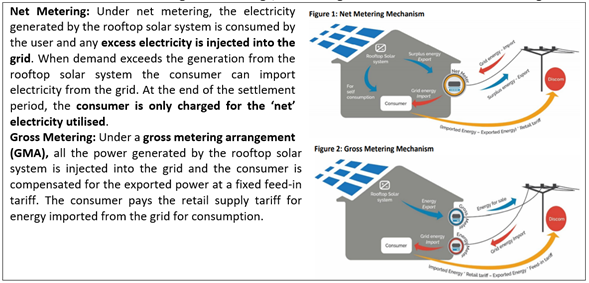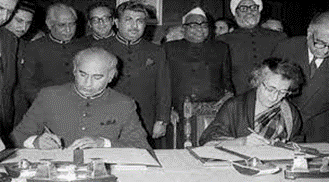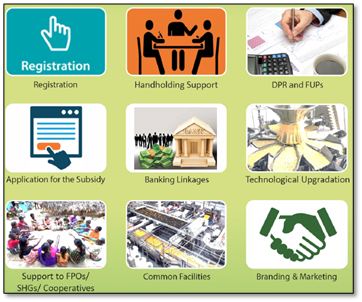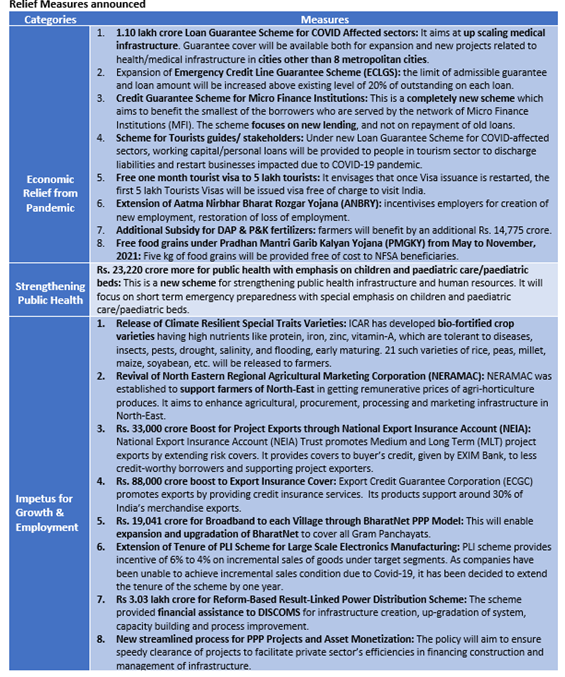Friday, 2nd July 2021
India's new net metering norms
In News
The Ministry of Power has issued the Electricity (Rights of consumers) (Amendment) Rules, 2021 to further amend the Electricity (Rights of consumers) Rules, 2020.
Key Amendments
- The amendments concern net metering for rooftop solar installations.
- It permits net metering to the prosumer (producer-cum-consumer) for loads up to 500kW or up to the sanctioned load, whichever is lower, and gross metering for loads over 500 kW.
- In either case of net-metering or gross metering, DISCOM may install a solar energy meter to measure the gross solar energy generated from the grid-interactive rooftop solar system for renewable energy purchase obligation (RPO) credit.
- The State Electricity Regulatory Commissions (SERC) may choose to introduce time-of-the-day tariffs where prosumers are incentivized to install energy storage for storing the solar energy or feeding it to the grid during peak hours. This could help the grid to manage the demand response.
- The amendment has also permitted gross metering for prosumers who would like to sell all the solar energy generated to DISCOM instead of using net metering. The Commission would decide the generic tariff for gross-metering as per tariff regulation.
- Amendments also define “gross-metering”, “net-billing or net feed-in” and “net-metering”.

Significance
- India has set an ambitious solar target, including the 40 GW of rooftop solar energy target by 2022. Net metering for rooftop solar systems was capped at 1MW until the government proposed to drastically cut it to 10 kW in December 2020.
- Labour and manufacturing units were also being affected and incurring excessive losses, adding to their liquidity deficits amid the COVID-19 crisis.
Thus, this move of promoting net metering is extremely important for the government to meet the target. This amendment is pro-consumers, -MSMEs and -new businesses. The power sector is witnessing a shift, where the dominance of DISCOMs will go away and power producers, DISCOMs, financiers and consumers will have to collaborate. Co-existence will be the mantra to move forward.
https://mercomindia.com/government-approves-net-metering-rooftop-solar/
Aluminium battery to take on lithium in EVs
In News
India plans to invest in a battery technology that uses aluminium rather than lithium as the key ingredient
About the News
- Aim: With the motive to reduce dependence on imported materials and technology, Indian Oil Corp., the nation’s largest oil refiner, has teamed up with start-up Phinergy Ltd. to develop the Israeli company’s aluminium-air battery.
- India’s Aluminium Capacity: India has few exploitable options to produce lithium, the key metal for the current generation of electric-vehicle batteries, but holds large bauxite reserves, the ore used to make aluminium. India is among the top 10 bauxite producers. It has some 600 million tons of the ore in proven reserves, according to the U.S. Geological Survey. Moreover, India has invested heavily in production of aluminium over the years to become the world’s second-biggest smelter of aluminium.
- Opportunity for India: India could provide a big market for aluminium-air batteries, as the demand both from electric transport and renewable energy storage are to increase. Battery demand will rise to as much as 185 gig watt hours by 2035.
- India’s dependence on fossil fuels has made it the world’s third-biggest emitter of greenhouse gases and Indian Oil is the nation’s biggest importer of crude oil. The success of Al-air battery can help tackle three urgent problems: cutting pollution, reducing raw material imports and creating jobs.
- Roadblock in the Plan: Given the ever-falling prices of lithium-based systems, developers will have to find niche applications where Aluminium-Oxygen can gain a foothold.

About Aluminium- air batteries
- Working: An aluminium-air cell consists of the same building blocks as any other battery – a pair of negative and positive electrodes (anode and cathode, respectively) and an electrolyte. In this case, the anode is formed by aluminium, while the ‘air-breathing’ cathode delivers oxygen from the ambient air. The electrolyte is water-based and is essentially a solution of potassium hydroxide or sodium hydroxide.
- Comparative advantage over Li-ion battery: An aluminium-air battery could win advantages over its lithium-ion battery through the following: It’s potentially cheaper, vehicles using it would have a longer range, and it’s safer.
- Energy density, e. energy produced per unit weight of the battery – very high compared to other conventional batteries, of Al-air battery is higher than that of lithium-ion cells, making them lighter, more compact and capable of delivering a much higher driving range than what is possible with today’s electric vehicles.
- Eco-friendly: Lithium-ion batteries often contain hazardous materials that can be toxic if not disposed of correctly, making them harder to recycle. Aluminium is easily recyclable.
World’s first plasmid DNA Covid vaccine
In News
Indian pharmaceutical major Zydus Cadila has applied for emergency use authorisation to the office of the Drug Controller General of India for ZyCoV-D, its plasmid DNA vaccine against Covid-19.
About the DNA Vaccine/ Plasmid DNA vaccines
- If approved for use, ZyCoV-D would be the world’s first DNA vaccine against Covid-19.
- It is a plasmid DNA vaccine. A plasmid, a small circular piece of DNA, is used to instruct cells to make the spike protein of the Sars-Cov-2. This helps teach the body to recognise a crucial part of the virus, to which it can then build defences.
- This technology involves direct administration of plasmid deoxyribonucleic acid (DNA) containing the part of the virus’ own genes to stimulate an immune response in the vaccine recipient.
Advantages of DNA Vaccines
- It stimulates both B-cell and T-cell responses. These are necessary for getting complete immunity.
- They can be made in a short time span – It may be feasible to produce the same DNA vaccine in different facilities in different countries to facilitate accessibility and availability of the vaccine thus ensuring a more stable supply of vaccine.
- DNA vaccines are easy to transport and store – DNA is a very stable molecule and does not need to be stored at low temperatures making transportation and storage cheaper and easier than conventional vaccines in the absence of a cold chain.
- DNA vaccines may be very cheap to make – it is relatively easy to make and purify large amounts of DNA.
- There is no risk to those who are making the vaccine - some conventional vaccines require growing up the infectious bacteria or virus – and this carries a risk (all be it very small) to those who work making vaccine.
- DNA vaccines do not generate anti-vector immunity or off-target acquired immunity to DNA in the vaccine recipient.
How is this different to conventional vaccines?
- Conventional vaccines, which expose the body to proteins made by a virus or bacteria, are often made by using weakened or inactive versions of that virus or bacteria. That’s how popular vaccines, like the measles, mumps, and rubella (MMR) vaccine and pneumococcal vaccine, work.
- A DNA or RNA (or mRNA) vaccine (Genetic Vaccines) has the same goal as traditional vaccines, but they work slightly differently. Instead of injecting a weakened form of a virus or bacteria into the body, DNA and RNA vaccines use part of the virus’ own genes to stimulate an immune response. In other words, they carry the genetic instructions for the host’s cells to make antigens.
How DNA Vaccines are different from mRNA vaccines?
- DNA is a two-stranded molecule while RNA is a single-stranded molecule. As such, the DNA molecule is more complex and needs to be converted into RNA which transmits instructions to the cell.
- With a DNA vaccine, the virus’ genetic information is transmitted to another molecule that is called the messenger RNA (mRNA). This means an RNA or mRNA vaccine is one step ahead of a DNA vaccine.
- DNA vaccines are believed to be more stable than their RNA counterparts owing to the presence of a substance called thymine. So, while mRNA vaccines may facilitate cell instruction better than DNA vaccines, the latter is safer to administer.
- Also, the DNA vaccine delivers the message via a small electrical pulse that pushes the message to the cell.
But with any health advancement comes potential risk. Experts says that with a DNA vaccine, there is always a risk it can cause a permanent change to the cell’s natural DNA sequence. Instead, mRNA cannot get integrated into the genetic material of a cell. It is also ready to be translated into protein.
Tags- , ,
Source-
The Drone Dilemma: A Revolutionary technology or a Security Nightmare
In News
Twin blasts took place on 27th June, at the Indian Air Force station in Jammu using two drones to drop the explosives on the air base.

About the News
- The attack, believed to be the first-ever offensive use of drones to target an Indian military facility, is a watershed in the asymmetric warfare between the two nations.
- Drones were used for the first time to drop explosive devices. However, over the past two years, drones have been deployed regularly by Pakistan-based outfits to smuggle arms, ammunition and drugs into Indian Territory. According to government figures, 167 drone sightings were recorded along the border with Pakistan in 2019, and in 2020, there were 77 such sightings.
- Weaponised drones were first used by the Islamic State in northern Iraq in 2016 and then in Syria.
What are Drones?
- The term “drone” usually refers to any unpiloted aircraft, sometimes referred to as “Unmanned Aerial Vehicles" (UAVs). A drone’s autonomy level can range from remotely piloted to advanced autonomy, which means that it relies on a system of sensors and LIDAR detectors to calculate its movement.
- Wherever drones have been used, it has been a strong force multiplier. Example, for increasing military capability, productivity of agriculture, delivery in remote locations, disaster management etc.
How have Drones become a Security threat?
- Stealth capability: Drone are difficult to detect. They are made of composite plastics and fabric and are not easily detectable by radars. Besides they fly ultra-low, below a 100ft. UAVs can also be used for many hours in a stretch, while switching operators. An attacker could use a UAV to spray a weaponised chemical or biological agent over a crowd of people.
- Easy availability: The recent commercial availability of a new generation of small UAVs, quadcopters or rotorcraft, has emphasised the growing threat posed by these machines. A recreational UAV can be turned into an aerial equivalent of an improvised explosive device (IED), or be equipped with a camera to spy.
- Difficult to differentiate: There have been many cases in which it was difficult to determine whether the UAV was being used for recreational use, newsgathering, activism, or for an activity that could result in harming public safety.
- Attractive to terrorists: Possibility to attack targets that are difficult to reach by land, covertness of attack preparation and flexibility in choice of launch site, accuracy, relative cost effectiveness, achieving strong psychological effect.
- Versatile Configurations: A drone can be configured to operate under radio silence, ignoring external Radio Frequency (RF) control commands and emitting no RF signals of its own. The UAV would thus be difficult to detect and would be impervious to command link jamming or hijacking.

Mitigation Steps
- Geo-fencing: They can prevent their UAVs from being flown within exclusion zones around airports, sports stadiums, government buildings, military bases and other security-sensitive sites.
- Detection Systems: Detection systems like Radars that have the fidelity to detect small objects, and operators trained to distinguish between birds and UAVs, Acoustic Sensors that operate by identifying the distinct noise made by the motors that drive the propellers of UAVs, Radio Frequency (RF) Emission sensors can detect the data sent back by Drones to their controller and Electro-Optical (EO) sensors in the form of optical and thermal cameras detection.
- Electronic Defence: Systems like Command Link Jamming and Appropriation which can effectively eliminate the ability of the UAV operator to conduct accurate targeting within the denied area and Global Navigation Satellite System (GNSS) Jamming and Spoofing can force attackers to operate either using line-of-sight (LOS) RC control, or non- GNSS autonomous navigation, using Directed Energy Weapons (DEWs) such as lasers for dazzling of sensors or by destructing the critical airframe components of the drone.
Way Forward
- DRDO technology: The Defence Research and Development Organisation (DRDO) has developed an anti-drone technology, which was deployed for Prime Minister’s security during the Independence Day address last August, has a range of two to three kilometres with radar capability to pick up the drone and then use frequencies to jam the unmanned aerial vehicle. Navy is also procuring Smash-2000 rifles to counter drones.
- Long-range drone flight trials: India has also finally initiated its long-range drone flight trials. Learnings from this will be used to frame the beyond visual line of sight (BVLOS) rules for drones. Currently, only drone flights within the operator’s visual line of sight (VLOS) are allowed, translating to around 450 metres in any direction.
- Counter-Unmanned Aircraft Systems (C-UAS): The Indian armed forces have indicated their intent to develop or acquire Counter-Unmanned Aircraft Systems (C-UAS) capability in the Technology and Capability Perspective Roadmap-2018 (TPCR).
- Drone attack as Ceasefire Violations: Drone attacks can be regarded as Ceasefire Violations, given the criticality of the location of the attack and its trailing impact on the geopolitical relations between the countries.
Question: Discuss the advantages and shortcomings of Drone Technology.
Tags- , , , Paper 3,
Secondary Sources: https://timesofindia.indiatimes.com/india/jammu-attack-why-stealth-drones-pose-lethal-threat-to-key-installations-in-india/articleshow/83895676.cms
This Day in History- Simla Agreement
On 2nd July, 1972, the Simla Agreement was signed by Indian Prime Minister Indira Gandhi and Pakistan President Zulfikar Ali Bhutto, as a peace treaty seeking to reverse the consequences of the 1971 war (i.e. to bring about withdrawals of troops and an exchange of PoWs). Under the Simla Agreement both countries undertook to abjure conflict and confrontation which had marred relations in the past, and to work towards the establishment of durable peace, friendship and cooperation. The Simla Agreement contains a set of guiding principles, mutually agreed to by India and Pakistan, which both sides would adhere to while managing relations with each other. These emphasize: respect for each other’s territorial integrity and sovereignty; non-interference in each other’s internal affairs; respect for each other’s unity, political independence; sovereign equality; and abjuring hostile propaganda.

Sources: https://mea.gov.in/in-focus-article.htm?19005/Simla+Agreement+July+2+1972
https://www.indiavsdisinformation.com/20191101/simla-agreement-between-india-pakistan
Image of the Day -Bioluminescence
This is the image of Bioluminescence, which is the light produced by a chemical reaction within a living organism. Most bioluminescent organisms are found in the ocean, where they provide almost all the light in the benthic (deep-sea) environment. Most bioluminescence is visible as bluish-green light. Most bioluminescent organisms can also only express one color. Bioluminescence is used by living things to hunt prey or distract predators. Milky seas offer a view of microscopic, bioluminescent organisms. Milky seas, like this appearance off the Horn of Africa, are caused by the presence of millions of bioluminescent bacteria on the surface of the ocean. Other outbreaks are associated with bioluminescent algae and changes in the marine environment, such as increased or decreased salinity.

https://www.canon.com.au/explore/bioluminescence-photography-tips
Global Cybersecurity Index (GCI)
- Context: India ranks 10th in GCI 2020 ahead of China and Pakistan.
- GCI is released by the International Telecommunication Union (ITU), the United Nations (UN) agency for Information and Communication Technologies (ICT).
- GCI assessment is done on the basis of performance on five parameters of cybersecurity including legal measures, technical measures, organisational measures, capacity development, and cooperation.
- The US ranked 1, followed by the UK and Saudi Arabia tied on the second position, while Estonia was ranked third in the index.
- India has jumped 37 places to secure 10th position overall and 4th position in the Asia Pacific region.
Primary source: https://indianexpress.com/article/india/india-ranks-among-top-10-in-itus-global-cybersecurity-index-7382520/
Picture source: https://defence.pk/pdf/threads/india-jumps-to-no-10-on-global-cyber-security-index-china-at-33-pakistan-79-un-study.715416/
https://www.itu.int/en/myitu/Publications/2021/06/28/13/22/Global-Cybersecurity-Index-2020
Guindy National Park
- Context: providing numerous ecosystem services to the people of Chennai.
- Ecosystem services are the direct and indirect contributions of ecosystems to human well-being.
- The Guindy National Park located at the heart of Chennai, is a small, protected area and serves as the green lungs to the city.
- The ecosystem services provided are sequestration of carbon dioxide, release of oxygen, conserving soil, preventing floods, mitigating climate change, improving water quality, generation of employment opportunities, revenue generation in addition to recreational, aesthetic and spiritual benefits.
- Organisms like worms, spiders, butterflies, etc. play a key role in the ecosystem, increasing soil fertility, helping in pollination, decomposing waste, etc.
Gamma Ray Burst (GRB) - Edukemy Current Affairs
- Context: unusual behaviour of afterglow of a Gamma-Ray Burst has been detected in space.
- GRBs are flashes of gamma radiation related to extreme energetic explosions detected in very distant galaxies.
- The intense radiation of GRBs is released during a supernova phase of a star when it implodes to form neutron star or black hole.
- They are the brightest electromagnetic events known to occur in the universe. The initial GRB is usually followed by a longer-lived afterglow, emitted at wavelengths such as X-ray, UV, visual, microwave, and radio wavelengths.
- The explosions could cause a mass extinction event if the burst occurs in the Milky Way, pointing directly towards the Earth.
Primary source: https://courses.lumenlearning.com/atd-fscj-introastronomy/chapter/gamma-ray-bursts-grbs/
https://en.wikipedia.org/wiki/Gamma-ray_burst
Picture source: https://www.airspacemag.com/daily-planet/mega-gamma-120577004/
AIM-iLEAP
- Context: Atal Innovation Mission (AIM) has concluded its first fintech cohort of ‘AIM-iLEAP’.
- AIM (by NITI Aayog) is a flagship initiative to promote a culture of innovation and entrepreneurship in the country.
- AIM-iLEAP (Innovative leadership for entrepreneurial agility and profitability) is a move to back tech start-ups with much-needed access to industry, markets and investors.
- It aims to bring together the start-ups, enterprises, investors and financers and create partnerships that would help these start-ups to take a leap forward in achieving more scalable and sustainable solutions.
- The objective of the initiative is to invite technology start-ups across a broad range of functions and have them present their solutions to the corporate leadership and innovation team for enabling market access and industry partnerships.
- The Fin-Tech cohort consisted of start-ups from a wide range of areas such as payments, international money transfers, personal finance, consumer banking, insurance, neo bank etc.
Primary source: https://pib.gov.in/PressReleasePage.aspx?PRID=1731689
Why a grassroots mass movement is necessary to fight dowry
Essence: Article highlights the issue of dowry in Indian society. It questions the prevalence of this practice in an age when moral outrage spreads faster over social media. Article suggests that accepting dowry should be made a social stigma by endorsing celebrities, all genders and generations, government, and teachers, etc. Also, we need to support women to be financially independent by creating safe and equal environment at workplace, public place and at home. Besides that, we need to screen laws and regulations to remove gender bias; zero tolerance policy to domestic violence; expansion of support system to victims, etc. To become a mass movement, this must start at grassroots by decentralising marriage registration (protects women’s rights) to panchayat secretaries along with systematic orientation of women’s self-help group (SHG) to provide support at local level so that a more equitable society can be built.
Why you should read this article?
- To get an overview of dowry system in India and reasons associated with it.
- To understand what can be done to tackle the same.
Article Link: https://indianexpress.com/article/opinion/columns/why-a-grassroots-mass-movement-is-necessary-to-fight-dowry-7385022/
Holistic skilling
Essence: Most innovations are products of human labour, genius, and sacrifice. The success of COVID19 vaccine is an interplay of capital, collaboration, regulatory mechanisms and, most importantly, the scientific and technological know-how, put simply, skills. This article, while critically analysing the initiatives taken by government in the skills sector, suggests stronger institutional framework for imparting skills and a supporting ecosystem.
Why you should read this article?
- Understand the issues with this year’s budget allocation for skilling, the Pradhan Mantri Kaushal Vikas Yojana, and the National Skill Development Agency (NSDA).
- Briefly know about the data on labour force and skilling.
- Know how the New Education Policy through integration of vocational and formal education emphasises on creation of an institutional framework with holistic approach towards of development skills.
https://www.thehindubusinessline.com/opinion/omkar-rai/article35084252.ece
Rule of Law vs Rule by Law
Essence: In this editorial, Chief Justice of India (CJI) N V Ramana brings light on the idea of Rule of law, need of analysis & role of judiciary in it. He starts with the basic idea of law & argues that a law cannot really be classified as a “law” unless it imbibes within itself the ideals of justice and equity. The British colonial power used the law as a tool of political repression, enforcing it unequally on the parties, with a different set of rules for the British and for the Indians. It was an enterprise famous for “Rule by Law”, rather than “Rule of Law”. Our struggle for independence thus marked our journey towards the establishment of a state defined by the Rule of Law.
From within the perspective of legal positivism, many conceptions of Rule of Law have emerged with emphasis on four principles. The first principle is that “laws must be clear and accessible,”. Second principle relates to the idea of “equality before the law”. Third principle, the “right to participate in the creation and refinement of laws”. Fourth and final principle: The presence of a “strong independent judiciary”. But judges should not be swayed by the emotional pitch of public opinion either, which is getting amplified through social media platforms.
Why you should read this article ?
- To understand the basic meaning of law & differentiation of “Just Law”
- To get insights into the core principles of “Rule of law”.
- To know about the link between law and justice.
- To understand the debate of Judiciary’s independence & judicial restraint.
IGugu Trust: Holistic Land Management Training in Zimbabwe
About IGugu Trust:
- It is a grassroot non-profit organization involved in regenerating degraded landscapes through holistic management of livestock and land.
Components involved:
- It provides training to rural communities on how to improve their livelihoods through planned grazing.
- It aims to conserve the grasslands by mimicking predator-prey relations in wild Africa.
- Holistic Land and Livestock Management is understood as a simple decision-making framework to manage the web of economic, social, and biological complexity.
Outcome:
- Social empowerment of women: Communities work together to manage land, cropland and rangelands, women and children are engaged in new responsibilities.
- Doubling of Harvest: The practices taught by IGugu Trust such as cattle “bomas” coupled with reducing land tillage can lead to a doubling of harvests.
- Improved social capital: Herder teams take turns managing herds, enabling families to rotate responsibility. Simultaneously, trust is built amongst neighbors resulting in the regeneration of social relations.
Source: https://www.unccd.int/actionsland-life-programme/land-life-award-2021-healthy-land-healthy-lives
Share the article
Get Latest Updates on Offers, Event dates, and free Mentorship sessions.

Get in touch with our Expert Academic Counsellors 👋
FAQs
UPSC Daily Current Affairs focuses on learning current events on a daily basis. An aspirant needs to study regular and updated information about current events, news, and relevant topics that are important for UPSC aspirants. It covers national and international affairs, government policies, socio-economic issues, science and technology advancements, and more.
UPSC Daily Current Affairs provides aspirants with a concise and comprehensive overview of the latest happenings and developments across various fields. It helps aspirants stay updated with current affairs and provides them with valuable insights and analysis, which are essential for answering questions in the UPSC examinations. It enhances their knowledge, analytical skills, and ability to connect current affairs with the UPSC syllabus.
UPSC Daily Current Affairs covers a wide range of topics, including politics, economics, science and technology, environment, social issues, governance, international relations, and more. It offers news summaries, in-depth analyses, editorials, opinion pieces, and relevant study materials. It also provides practice questions and quizzes to help aspirants test their understanding of current affairs.
Edukemy's UPSC Daily Current Affairs can be accessed through:
- UPSC Daily Current Affairs can be accessed through Current Affairs tab at the top of the Main Page of Edukemy.
- Edukemy Mobile app: The Daily Current Affairs can also be access through Edukemy Mobile App.
- Social media: Follow Edukemy’s official social media accounts or pages that provide UPSC Daily Current Affairs updates, including Facebook, Twitter, or Telegram channels.





